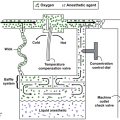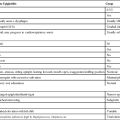Implantable cardioverter-defibrillators
Intraoperative management
No special monitoring or anesthetic technique is required for the patient with an ICD. However, the Heart Rhythm Society and American Society of Anesthesiologists have developed guidelines and recommendations for how the patient with an ICD coming to the operating room for an elective procedure (Box 152-1) or an emergent procedure (Box 152-2) should be managed. Electrocardiographic monitoring and the ability to deliver prompt external cardioversion or defibrillation must be present if the ICD is being disabled, are recommended whether or not the device is used for pacing, and are recommended whether or not the patient is pacemaker dependent (Box 152-3). Should external defibrillation become necessary, device manufacturers recommend using the lowest possible energy, placing the paddles perpendicular to the path of the implanted leads, and keeping the paddles away from the implanted generator, the same as with a standard pacemaker device. The guidelines outline when and how the ICD must be reinterrogated and reenabled postoperatively (Box 152-4).




